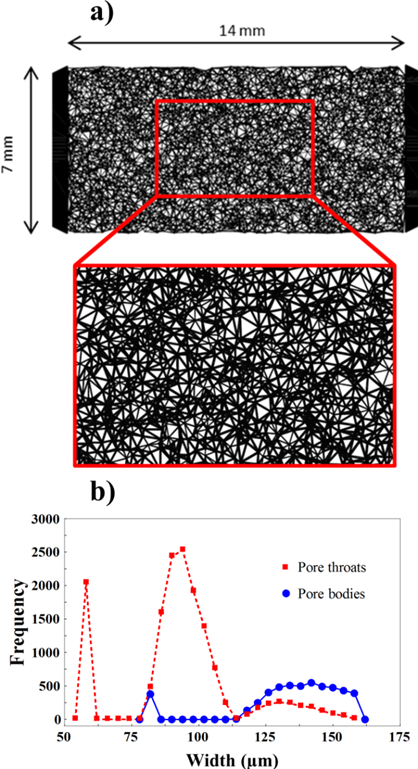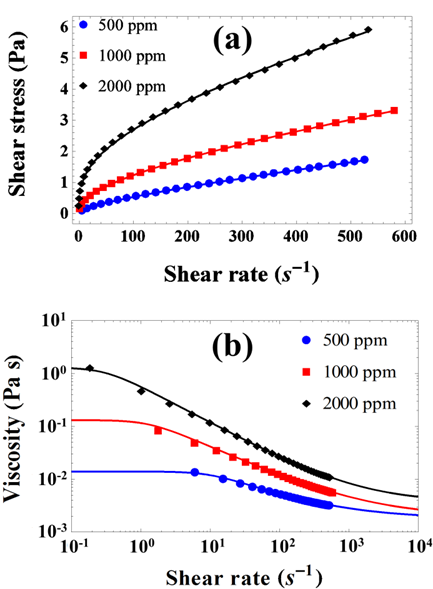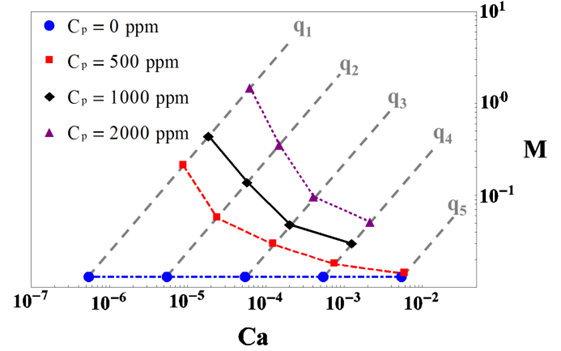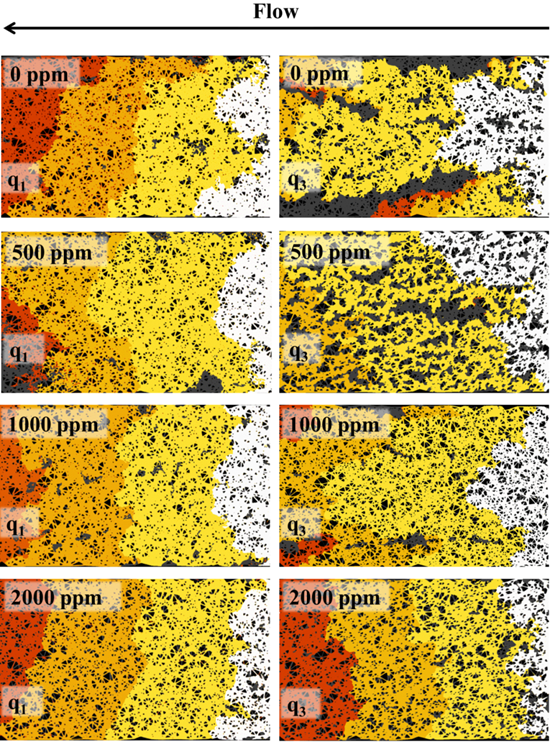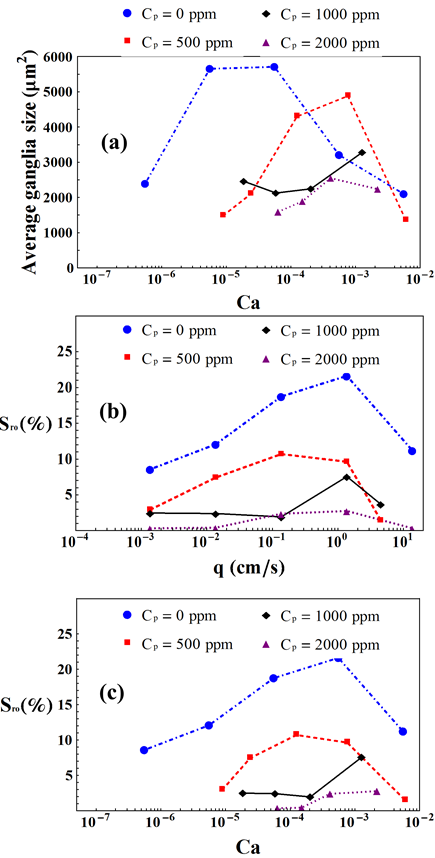Reports: DNI652054-DNI6: Fundamental Studies of the Morphology and Dynamics of the Phase Entrapment in Immiscible Two-Phase Flow through Porous Media
Nima Shokri, PhD, University of Manchester
Two-phase immiscible displacement in porous media is controlled by capillary and viscous forces when gravitational effects are negligible. The relative importance of these forces is quantified through the dimensionless capillary number Ca and the viscosity ratio M between fluid phases. When the displacing fluid is Newtonian, the effects of Ca and M on displacement patterns can be evaluated independently. However, some of the most popular injecting fluids used in EOR and in soil remediation practices are non-Newtonian such as polymer solutions, foams or emulsions, and present shear-thinning behaviour, i.e. the viscosity of the fluid decreases as the applied shear stress increases. When injecting fluids exhibit shear-thinning viscosity behaviour the values of M and Ca are interdependent and are influenced by the flow rate.
Motivated by the widespread use of shear-thinning fluids in porous media and its great potentials in enhanced oil recovery and soil remediation, we investigated how Ca and M affect residual oil saturation Sro and trapped blob distributions during immiscible two-phase flow in porous media involving shear-thinning fluids.
Experimental considerations:
Micromodel. Figure 1 shows the design of the micromodel and its pore body and throat distributions. The micromodel was fabricated in a silicon wafer using standard photolithography and inductively coupled plasma–deep reactive ion etching methods. The micromodel was chemically treated to be cleaned and to acquire uniform wettability.
Figure 1. (a) Dimensions and patterns of the micro-model. Black and white represents pores and solid matter, respectively. (b) Distribution of widths of the pore bodies and throats.
Fluid properties. The used resident fluid was Xiameter® PMX – 200 Silicone Fluid. The displacing fluids were aqueous solutions with dissolved xanthan gum powder concentrations of 0, 500, 1000, and 2000 ppm. The polymer solutions were characterized by means of a stress controlled rheometer. The obtained rheograms are displayed on Figure 2(a) and the effective viscosities as a function of shear rate are shown in Figure 2(b).
Figure 2. (a) Rheograms and (b) effective viscosity vs. shear rate.
Displacement experiments. The experiments consisted of displacement of resident silicone fluid by four aqueous polymer solutions (0, 500, 1000, and 2000 ppm xanthan), at five flow rates. An overview of the displacement flow rates and associated Darcy velocities are presented in Table 1. The listed experiments were conducted for all four concentrations and were repeated five times.
Table 1. Overview of flow rates and associated Darcy velocities for an experimental set, each conducted with 0, 500, 1000, and 2000 ppm polymer concentration.
|
Experiment Index i |
Flow Rate, Qi (ml/hr) |
Darcy Velocity, qi (cm/s) |
|
1 |
10-2 |
1.368 x 10-3 |
|
2 |
10-1 |
1.368 x 10-2 |
|
3 |
100 |
1.368 x 10-1 |
|
4 |
101 |
1.368 x 100 |
|
5 |
102 |
1.368 x 101 |
The dynamics of interface displacement as well as the size distribution of the trapped oil ganglia were visualized using an optical microscope (Leica M205C) equipped with a high-resolution digital camera. The obtained images were analysed using ImageJ software.
Results and discussion:
Figure 3 shows the capillary numbers and viscosity ratios corresponding to each polymer concentration at different flow rates. Figure 3 shows that the value of Ca increases for a constant q as Cp increases. When Ca increases, viscous forces dominate the interface displacement. Therefore, capillary fingering will be less significant as Cp increases.
Figure 3. Mobility ratio (M) as a function of the capillary number (Ca) for each Cp value.
Interface displacement. Dynamics of the interface displacement as a function of Cp are shown in Figure 4 for q1 and q3. This figure shows that the invading front is stable at q1 for all values of Cp. In contrast, viscous fingering leading to a large amount of bypassed oil is observed at q3 and Cp = 0 ppm. At this higher flow rate, the increase of M with increasing Cp is more moderate than that for the displacement with q1. However, the corresponding increase in Ca is also more moderate, leading to the front being progressively stabilised as Cp increases (Figure 4).
Figure 4. Fluid saturations at times t, t + Δt, t + 2Δt and t + 3Δt with Δt being 240 sec for q1 and 2 sec for q3 represented by white, light orange, dark orange and brown. The dark zones represent solid matter. Grey represents the regions of the pore space filled by oil at t + 3Δt.
Efficiency of polymer flooding. Figure 5(a) displays the average area of the trapped ganglia as a function of Ca. Results show that the average ganglia size at any Ca is effectively reduced by adding polymer to the injecting water. Figure 5(a) shows that the largest blob sizes are obtained at intermediate values of Ca due to viscous fingering dominating the propagation of the invading front.
Figure 5. Average ganglia size as a function of Ca (a), Sro as a function of q (b), and Sro as a function of Ca (c).
Residual oil saturations (Sro) were calculated from the segmented images and represented as a function of q in Figure 5(b) showing that Sro reduces in the case of polymer waterflooding compared to waterflooding for all q values. Additionally, Figure 5(c) shows that Sro decreases with increasing Cp at every value of overlapping Ca values considered in our study. It should be noted that high viscosities of the concentrated polymer solutions generate high viscous pressure drops that are capable of mobilising or fragmenting the large ganglia easier than diluted polymer solutions. More comprehensive analysis of the obtained results has been submitted as a research paper for possible publication in a high impact factor journal. The paper is currently in review.
In addition to the above mentioned research, this funding was used to support the research of two PhD students (about salt precipitation in porous media and foam flow in porous media) which resulted in several publications. Funding of this proposal was extremely useful for the PI at a critical stage of his career. This funding helped him to initiate a new line of research and expand his research group (currently including 7 PhD students).

